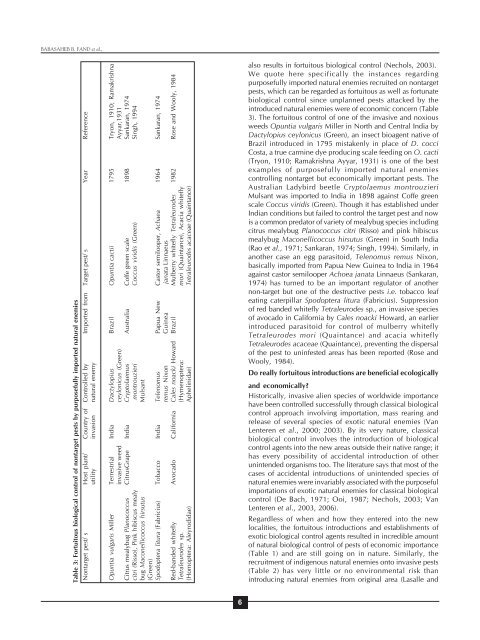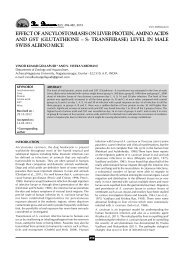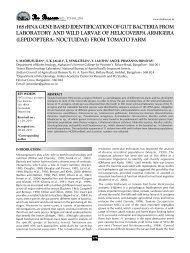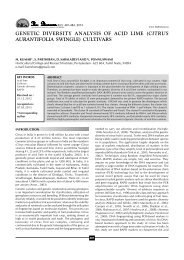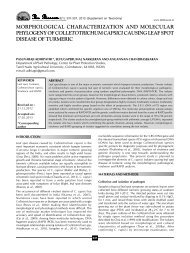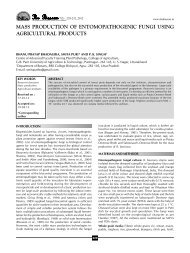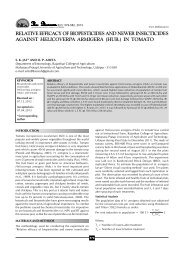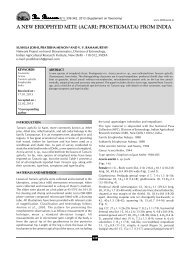BABASAHEB B. FAND et al.,Table 3: <strong>Fortuitous</strong> <strong>biological</strong> <strong>control</strong> <strong>of</strong> nontarget <strong>pests</strong> by purposefully imported natural enemiesNontarget pest/ s Host plant/ Country <strong>of</strong> Controlled by Imported from Target pest/ s Year Referenceutility invasion natural enemyOpuntia vulgaris Miller Terrestrial India Dactylopius Brazil Opuntia cactii 1795 Tryon, 1910; Ramakrishnainvasive weed ceylonicus (Green) Ayyar,1931Citrus mealybug Planococcus CitrusGrape India Cryptolaemus Australia C<strong>of</strong>fe green scale 1898 Sankaran, 1974citri (Risso), Pink hibiscus mealy montrouzieri Coccus viridis (Green) Singh, 1994bug Maconellicoccus hirsutus Mulsant(Green)Spodoptera litura (Fabricius) Tobacco India Telenomus Papua New Castor semilooper, Achaea 1964 Sankaran, 1974remus Nixon Guinea janata LinnaeusRed-b<strong>and</strong>ed whitefly Avocado California Cales noacki Howard Brazil Mulberry whitefly Tetraleurodes 1982 Rose <strong>and</strong> Wooly, 1984Tetraleurodes sp. (Hymenoptera: mori (Quaintance), Acacia whitefly(Homoptera: Aleyrodidae) Aphelinidae) Tetraleurodes acaceae (Quaintance)also results in fortuitous <strong>biological</strong> <strong>control</strong> (Nechols, 2003).We quote here specifically the instances regardingpurposefully imported natural enemies recruited on nontarget<strong>pests</strong>, which can be regarded as fortuitous as well as fortunate<strong>biological</strong> <strong>control</strong> since unplanned <strong>pests</strong> attacked by theintroduced natural enemies were <strong>of</strong> economic concern (Table3). The fortuitous <strong>control</strong> <strong>of</strong> one <strong>of</strong> the invasive <strong>and</strong> noxiousweeds Opuntia vulgaris Miller in North <strong>and</strong> Central India byDactylopius ceylonicus (Green), an <strong>insect</strong> bioagent native <strong>of</strong>Brazil introduced in 1795 mistakenly in place <strong>of</strong> D. cocciCosta, a true carmine dye producing scale feeding on O. cacti(Tryon, 1910; Ramakrishna Ayyar, 1931) is one <strong>of</strong> the bestexamples <strong>of</strong> purposefully imported natural enemies<strong>control</strong>ling nontarget but economically important <strong>pests</strong>. TheAustralian Ladybird beetle Cryptolaemus montrouzieriMulsant was imported to India in 1898 against C<strong>of</strong>fe greenscale Coccus viridis (Green). Though it has established underIndian conditions but failed to <strong>control</strong> the target pest <strong>and</strong> nowis a common predator <strong>of</strong> variety <strong>of</strong> mealybug species includingcitrus mealybug Planococcus citri (Risso) <strong>and</strong> pink hibiscusmealybug Maconellicoccus hirsutus (Green) in South India(Rao et al., 1971; Sankaran, 1974; Singh, 1994). Similarly, inanother case an egg parasitoid, Telenomus remus Nixon,basically imported from Papua New Guinea to India in 1964against castor semilooper Achoea janata Linnaeus (Sankaran,1974) has turned to be an important regulator <strong>of</strong> anothernon-target but one <strong>of</strong> the destructive <strong>pests</strong> i.e. tobacco leafeating caterpillar Spodoptera litura (Fabricius). Suppression<strong>of</strong> red b<strong>and</strong>ed whitefly Tetraleurodes sp., an invasive species<strong>of</strong> avocado in California by Cales noacki Howard, an earlierintroduced parasitoid for <strong>control</strong> <strong>of</strong> mulberry whiteflyTetraleurodes mori (Quaintance) <strong>and</strong> acacia whiteflyTetraleurodes acaceae (Quaintance), preventing the dispersal<strong>of</strong> the pest to uninfested areas has been reported (Rose <strong>and</strong>Wooly, 1984).Do really fortuitous introductions are beneficial ecologically<strong>and</strong> economically?Historically, invasive alien species <strong>of</strong> worldwide importancehave been <strong>control</strong>led successfully through classical <strong>biological</strong><strong>control</strong> approach involving importation, mass rearing <strong>and</strong>release <strong>of</strong> several species <strong>of</strong> exotic natural enemies (VanLenteren et al., 2000; 2003). By its very nature, classical<strong>biological</strong> <strong>control</strong> involves the introduction <strong>of</strong> <strong>biological</strong><strong>control</strong> agents into the new areas outside their native range; ithas every possibility <strong>of</strong> accidental introduction <strong>of</strong> otherunintended organisms too. The literature says that most <strong>of</strong> thecases <strong>of</strong> accidental introductions <strong>of</strong> unintended species <strong>of</strong>natural enemies were invariably associated with the purposefulimportations <strong>of</strong> exotic natural enemies for classical <strong>biological</strong><strong>control</strong> (De Bach, 1971; Ooi, 1987; Nechols, 2003; VanLenteren et al., 2003, 2006).Regardless <strong>of</strong> when <strong>and</strong> how they entered into the newlocalities, the fortuitous introductions <strong>and</strong> establishments <strong>of</strong>exotic <strong>biological</strong> <strong>control</strong> agents resulted in incredible amount<strong>of</strong> natural <strong>biological</strong> <strong>control</strong> <strong>of</strong> <strong>pests</strong> <strong>of</strong> economic importance(Table 1) <strong>and</strong> are still going on in nature. Similarly, therecruitment <strong>of</strong> indigenous natural enemies onto invasive <strong>pests</strong>(Table 2) has very little or no environmental risk thanintroducing natural enemies from original area (Lasalle <strong>and</strong>6
Table 4: Nontarget effects <strong>of</strong> fortuitously introduced <strong>biological</strong> <strong>control</strong> agentsIntroduced natural enemy Species affected Ecological effect Country/ Region ReferenceCoccinella septumpunctata Coccinella transverguttata, Reduced abundance South Dakota Elliot et al.,1996(Coleoptera: Coccinellidae) Adalia bipunctata (Coleoptera: <strong>and</strong> competitiveCoccinellidae)displacementCoccinella maculate Reduced abundance Iowa Obracky et al., 1998(Coleoptera: Coccinellidae) <strong>and</strong> competitive displacementDiplazon laetatorius (F.) Native predator species Hyperparasitism, New Zeal<strong>and</strong>. Charles, 1998(Hymenoptera:Ichneumonidae)reduced abundanceAnacharis zeal<strong>and</strong>ica Ashmead(Hymenoptera: Figitidae)Pena, 1997; Gao <strong>and</strong> Li, 2006). Many times, natural enemiescan easily be accessed for importation from accidentallyintroduced areas than from their native homes. Otherwise, itcan be said that the fortuitous <strong>biological</strong> <strong>control</strong> is not only asan accidental but also a fortunate phenomenon since the <strong>pests</strong>carry along with them the beneficial species to the new areas(Nechols, 2003). Accompanying <strong>of</strong> natural enemies mayprevent the establishment <strong>of</strong> exotic pets in new areas <strong>and</strong> thusinvasive species is stopped from assuming status <strong>of</strong> aneconomic pest (De Bach, 1971).Since the fortuitous <strong>biological</strong> <strong>control</strong> occurs accidentallywithout involving any human efforts, it helps saving a lot <strong>of</strong>time <strong>and</strong> money that needs to be spent for the purposefulimportations <strong>of</strong> <strong>biological</strong> <strong>control</strong> agents as in case <strong>of</strong> classicalapproach. As the pest is kept below economically damaginglevels naturally by reestablishment <strong>of</strong> balance between theinvasive pest <strong>and</strong> fortuitous natural enemy, it may helpreducing unwanted pesticide applications. Consequently itenhances the environmental quality through reduced pesticidepollution.Environmental Concerns <strong>of</strong> <strong>Fortuitous</strong> Introductions<strong>Fortuitous</strong> establishment <strong>of</strong> natural enemies <strong>of</strong> <strong>insect</strong> <strong>pests</strong><strong>and</strong> weeds in new areas appear to be a very commonphenomenon, invariably associated with the importations <strong>of</strong>exotic natural enemies to <strong>control</strong> invasive <strong>pests</strong> (De Bach,1971; De Bach <strong>and</strong> Rosen, 1991; Nechols, 1995; 2003;SCOPE, 1996; Charles, 1998; van Lenteren et al., 2003; 2006)<strong>and</strong>/ or increased transboundary movements <strong>of</strong> agriculturalproduce through world trade (Ooi, 1987; Charles, 1998;McNeely, 2001; Murphy, 2004; Ramani, 2004). According tothe literature survey, introductions <strong>of</strong> <strong>biological</strong> <strong>control</strong> agentsduring past twelve decades for the <strong>control</strong> <strong>of</strong> arthropod <strong>pests</strong>globally rarely have caused the negative environmental effects(Sailor, 1978; Charles, 1998) <strong>and</strong> in most <strong>of</strong> the cases <strong>of</strong> exoticintroductions the benefits outweigh the risks.However, environmental risks from releases <strong>of</strong> exotics are <strong>of</strong>growing concern both for ecologists <strong>and</strong> entomologists.Accidental introductions <strong>of</strong> unintended species <strong>and</strong>introduction <strong>of</strong> species that attacks natural enemies <strong>of</strong>ecological or economic value are the major risks associatedwith the exotic introductions for <strong>biological</strong> <strong>control</strong> leading tothe <strong>biological</strong> invasion (Messing, 1999; Gao <strong>and</strong> Li, 2006).Accidentally introduced organisms because <strong>of</strong> their invasivenature greatly outnumber natural enemies those areintentionally introduced (van Lenteren et al., 2006) whichmay lead to competitive displacement <strong>and</strong> reducedabundance <strong>of</strong> native species as documented in case <strong>of</strong>Coccinella septumpunctata (L.) competitively replacingCoccinella transversoguttata Fald <strong>and</strong> Adalia bipunctata (L.)in South Dakota (Elliot et al., 1996) <strong>and</strong> Coccinella maculatain Iowa (Obracky et al., 1998). Thus the native species are putat the risk <strong>of</strong> extinction by fortuitously introduced naturalenemies. Nontargets becoming targets is another danger <strong>of</strong>species invasions as reported by Charles (1998) where two <strong>of</strong>the accidentally introduced Hymenopteran parasitoids,Diplazon laetatorius (F.) (Ichneumonidae) <strong>and</strong> Anachariszeal<strong>and</strong>ica Ashmead (Figitidae) attacked native predators inNew Zeal<strong>and</strong>. Accidentally introducing unwanted organismsmay contaminate the cultures <strong>of</strong> intended <strong>insect</strong>s <strong>and</strong>microorganisms whereas some natural enemies are capable<strong>of</strong> carrying spores <strong>of</strong> unwanted plant pathogens which maylead to disease epidemics in the area <strong>of</strong> invasion.Hyperparasitoids accidentally entering along with the intendedspecies may contaminate <strong>and</strong> kill the cultures <strong>of</strong> <strong>biological</strong><strong>control</strong> agents, which upon release <strong>and</strong> establishment mayreduce the effectiveness <strong>of</strong> the <strong>biological</strong> <strong>control</strong> agents (DeBach <strong>and</strong> Rosen, 1991; Nechols, 1995; 2003; Charles, 1998).Even though, the causes <strong>of</strong> <strong>biological</strong> invasions are manifold<strong>and</strong> multifaceted (Dukes <strong>and</strong> Mooney, 1999), <strong>biological</strong><strong>control</strong> <strong>and</strong> global climate change are recognised as primarydrivers <strong>of</strong> species invasion. Convention on Biological Diversity(CBD) treats the invasive alien species as the greatest threat toloss <strong>of</strong> biodiversity in the world affecting ecosystems’functioning (Mooney <strong>and</strong> Hobbs, 2000).What NextBiological invasions <strong>and</strong> global species extinction are seemsto be the greatest threats from <strong>biological</strong> <strong>control</strong> introductions.Despite numerous hurdles to the underst<strong>and</strong>ing <strong>and</strong> dealingwith the problem <strong>of</strong> <strong>biological</strong> invasion, a well focused <strong>and</strong>coordinated legal <strong>and</strong> organizational approach is essential tomeet this challenge. Most <strong>of</strong> the countries in the world have awell developed regulatory structure in place in order to preventunwanted <strong>biological</strong> pollution. As the fortuitous <strong>biological</strong><strong>control</strong> is going on unnoticed continuously in <strong>and</strong> around us,extensive pest surveillance in areas having probabilities <strong>of</strong>exotic introductions such as airports, sea ports, military camps,railway stations <strong>and</strong> their surrounding areas needs to beundertaken which may help adding to our knowledge <strong>of</strong> apoorly documented, yet another important component <strong>of</strong>naturally occurring <strong>biological</strong> <strong>control</strong>. Similarly, adverse effectsor risk associated with the accidental entries if any, could beidentified <strong>and</strong> due measures could be undertaken to mitigatethe same. It is anticipated that because <strong>of</strong> globalization <strong>and</strong>7


